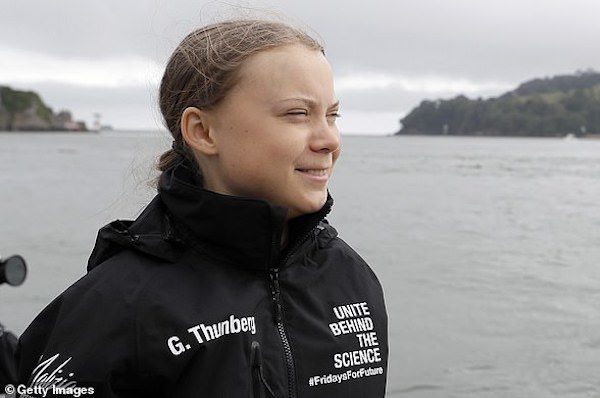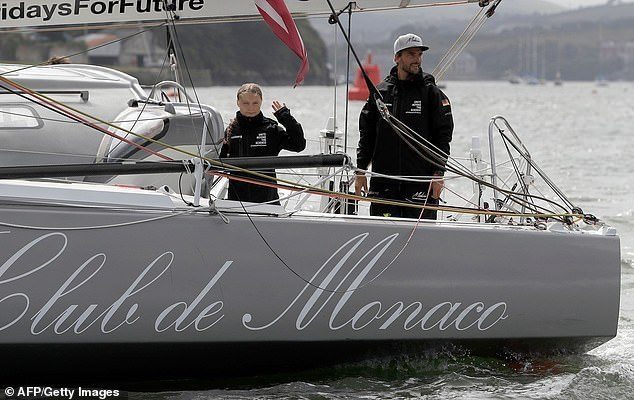
It is claimed that this would generate more emissions than the yacht saves and threatens to leave the 16-year-old's plans to chart an environmentally friendly route to the United States in tatters.
On Wednesday, the Swedish eco-campaigner left Plymouth on the Malizia II for a two-week journey to the United Nations headquarters where she will address a climate change meeting.
But last night, it was confirmed that two crew will have to fly to the US east coast city to man the 60ft yacht on its return.
'We added the trip to New York City at very short notice, and as a result two people will need to fly over to the US in order to bring the boat back,' a Team Malizia spokeswoman told the Times.
She added: 'The world has not yet found a way to make it possible to cross an ocean without a carbon footprint.'
And a further two sailors who are currently on board the Malizia II with Greta may use air travel to get back to Europe.
Skipper Boris Herrmann and Pierre Casiraghi, the nephew of Prince Albert of Monaco, will reportedly be boarding flights for their return trip.
Greta, who is taking a sabbatical year from school, will be joining large-scale climate demonstrations and speaking at the UN Climate Action Summit hosted by secretary-general Antonio Guterres in New York in September.
She is also planning to visit Canada and Mexico before travelling to this year's UN climate conference, which is taking place in Santiago, Chile, in December, making her journeys by train and bus.
The two-week sailing trip means she can attend the summits without using planes or cruise ships which cause greenhouse gas emissions.
She said her adventure would have challenges including seasickness but said many people in the world were suffering a lot more than that.
To keep herself occupied during the journey she has books, board games and a rabbit teddy bear, which was a gift from a friend.
The journey takes about two weeks - the yacht can travel at speeds of around 43mph but will be heading into the wind for much of the time so will be slower, and the captain wants a smooth ride.
Before setting sail, Herrmann said: 'The objective is to arrive safe and sound in New York.'
The yacht is made for racing, with foils, or wings, that lift it out of the water for a faster and smoother ride.
Inside it is sparse, fitted with high-tech navigation equipment, an on-board ocean laboratory to monitor CO2 levels in the water, and four bunks - Herrmann and Casiraghi will share one, sleeping in turns.
The toilet is a blue plastic bucket, complete with a biodegradable bag that can be thrown overboard, and meals will be freeze-dried packets of vegan food mixed with water heated on a tiny gas stove.
But state-of-the-art solar panels adorn the yacht's deck and sides while there are two hydro-generators, which together provide all the electricity they need on board.
How did Swedish teenager Greta Thunberg become the poster girl for the climate change movement?
Greta Thunberg, pictured, is a teenager who began a solo protest outside the Swedish parliament last year which has since spread across the globe. The Fridays For Future events saw young people demand that their government takes action against climate change
Comment: See also:
Greta Thunberg, pictured, is a teenager who began a solo protest outside the Swedish parliament last year which has since spread across the globe. The Fridays For Future events saw young people demand that their government takes action against climate change
The youth-led climate protests which kicked off across the world were inspired by Greta Thunberg, a Swedish teenager who went on a three-week school strike outside her country's parliament in summer last year.
Born to a professional opera singer mother, the pigtailed 16-year-old developed her interest in climate change aged nine after watching a film on the effects of plastic.
What began as a lone fight in August last year outside the Swedish parliament spread all over the world and involved more than 100,000 schoolchildren in 112 different countries.
The movement was called Fridays For Future and consisted of students taking every Friday off to demand government action on the climate issue.
Greta has Asperger's and ADHD but has often spoken on how her conditions have acted as a motivator instead of a source of depression, which she said they once were.
Since her first strike last year at the age of 15, Greta has gone on to talk about the possible solutions to combat climate change at rallies in Stockholm, Helsinki, Brussels and London. Every conference she has attended she has travelled by train, bus or cycled in an effort to keep her carbon footprint low.
Over the last few years she has convinced her family to make drastic changes in order to help save the planet including refusing to fly on planes, growing their own vegetables and not eating meat.
Greta was nominated for a Nobel Peace Prize by members of Norway's Parliament for her work and determination, and she received the freedom of expression, Fritt Ord Prize, in April.
Greta is setting sail on 60ft racing boat Malizia II to get to this year's UN Climate Action Summit in New York and the COP25 climate change conference in Santiago.




R.C.